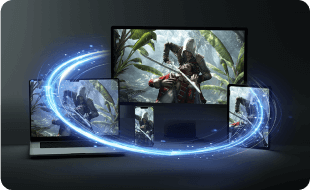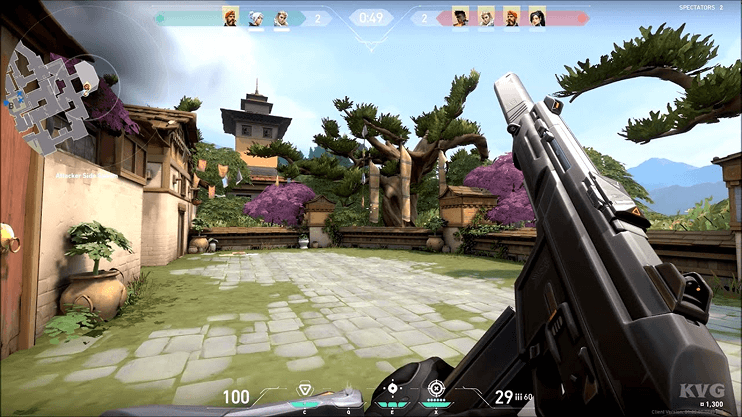
Console Game Development
Most Reliable Console Gaming Solutions
Developing cutting-edge games that offer reliable performance on PlayStation, Xbox, Nintendo Switch, PC, and mobile for a unified gaming experience.

12+
Years of Expertise
50+
Projects Completed
10M+
Game Downloads

Our Console Game Development Services
The games we develop are interactive and enhance your satisfaction as you play the game on various platforms and devices with different operating systems.

PlayStation Game Development
We are a dedicated team creating premium PlayStation games with focus on achieving maximum performance on both PS4 & PS5 platforms.

Xbox Game Development
We provide beautiful and highly functioning Xbox games for our clients and are compatible with all the current models of Xbox.

Nintendo Switch Game Development
Our games are lively and entailing and are developed based on the features of the Nintendo Switch Console.

Game Monetization Strategies
Developing effective monetization strategies for console games, from in-app purchases to ads.

Mobile Game Development
As expected, we develop games that are compatible with both the iPhone and Android-based platforms.

Cloud-Based Game Development
Using cloud technology, we build generic and cloud-based accessible games on different platforms.

Multiplayer & Online Game Development
We create fun multiplayer and online games which are built on a solid networking foundation and incorporate real-time activity.

Game Porting & Optimization
Our dedicated team is expert in porting games from one platform to the other, improving performance and compatibility.

AR/VR Game Development
We design and create true-to-life augmented and virtual reality games that redefine interactive gaming.
The Console Game Advantage
Future-Proof Game Development for All Platforms
Players nowadays are very picky about what games they are playing and where they are playing them, so the more platforms a game can support, the better. The potential of console game development is massive, with the global mobile gaming market alone projected to reach $775.69 billion by 2032. Our focus is on creating engaging game content.








Expanding Gaming Horizons Across Platforms!
Key Steps In Our console Game Development


Take Your Game to the Next Level!
Enhance your game’s performance, visuals, and functionality with our expert console game development services.
Get Started

Getting Started with Console Game Development

How does console game development impact game performance?
Approximately one-third of developers use console technologies or frameworks. console game development means that the game can be run on different platforms, including mobile platforms and gaming platforms such as PlayStation, Xbox, and Nintendo Switch. But these results are achieved mostly for several simple applications without the need of using any framework, which is important because current social gaming platforms have different technical specifications to fulfill and require the same user experience from players.
One of the major issues that can arise from console game development is the issue of graphical quality, or FPS and load time differences between various platforms. The nature of each platform is different, both in terms of the device and the software that is employed and the developers need to make sure the game runs well on all of them.
For instance, the hardware behind console games is usually far more advanced compared to that used for mobile gaming despite the fact that mobile games have to be designed for the lower power consumption of the devices and the screen sizes. It also depends on graphics, and game resolution along with the game mechanics that must not put too much stress on the gaming platform.
However, one key concern that arises when developing a game for both the phone and PC is to be able to maintain a consistent frame rate. Being expensive and powerful, consoles and PCs are capable of providing a high frame rate which is again beneficial for the players in terms of the game.
On the other hand, it is usually a problem of driving the frame rate as high on a mobile device, especially putting into consideration that graphically intensive games are also more demanding. Developers can also recognize and improve the assets that they used in creating the game also in the graphic settings like the texture resolution that will enable the game to run at the same speed in both devices.
What are the challenges of console game development, and how can they be overcome?
console game development is a current trend that allows the creation of video games capable of running on different platforms like PlayStation, Xbox, Nintendo Switch, mobile devices, PC, and others. As stated earlier, there are benefits in console game development, but there are also certain disadvantages.
Here are some of the most basic difficulties and approaches towards tackling them:- Platform-Specific Technical Constraints
- Ensuring Consistent Gameplay Across Devices
- Handling Multiplayer and Online Connectivity Issues
- Testing and Debugging
All gaming platforms, such as PlayStation, Xbox, and those that run on mobile gadgets, possess peculiar hardware and software environments that dramatically affect game performance. For instance, the graphical interface on high-end gaming consoles may be far better than that of mobile devices, and therefore, there is a likelihood of experiencing performance differences.
Solution: can counter these differences by adopting dynamic scaling, where game operators can alter the graphics quality depending on the platform's capabilities. This may involve lowering details in detailed environments or controlling FPS rates with low-level machines while giving high-end PCs perfect graphics and performance.
One of the biggest problems here is the issue of game design uniformity across different platforms of play, such as mobile, console, and PC. When a game transitions from one platform to another, such as moving from a game console to a PC, it becomes a challenge to keep all the aspects of the game playing out to be the same.
Solution: To address this, developers should strive to incorporate designs that are flexible enough to adapt. Some of the suggestions that were provided include setting the game's UI for different-sized displays and allowing the gamer to have personalized controls. For instance, those who are engaged on consoles can use specific controllers, while those on devices such as smartphones and tablets can use touch screens or connect external controllers.
Multiplayer games are common to attract a large number of people with console play. It is important not to have game-play (for example, between PlayStation, Xbox, and PC users) as it complicates matters in terms of synchronizing the play sessions, handling the complications arising out of latency problems, match-making, and data synchronization.
Solution: The key problem of the above scenarios can be addressed using cloud services and dedicated servers that allow consolidating data management and providing players with fast access with minimal latency. There should also be an emphasis on unifying networks and servers; no matter which game is executed by which platform, it should work as it is supposed to.
When one is working on the file or attempting to make a program, testing is always a complex process when developing for many platforms at once. The nature of their development, bugs and system settings may vary on each of them, thus needing appropriate testing effort. This makes it even more time and cost intensive to ensure all these features enable the game to run to completion seamlessly on current and future devices.
Solution: To mitigate this, developers can use console game development tools like Unity or Unreal Engine, which allow for simultaneous testing and debugging. Additionally, a cloud-based testing infrastructure can automate the process, enabling developers to test the game on various platforms without needing to manually configure each one.
How does console game development benefit developers and players?
Implementing console functionality can boost game revenue by 20% to 40%, as it broadens the player base and enhances engagement. Console game development is the process through which game development takes place on different platforms such as console devices, mobile devices, PCs, PlayStation, Xbox, or Nintendo Switch, among others.
It affords several opportunities and benefits for both developers and players, which have, in one way or another, helped in the success of the game and its acceptance globally. As a result, the following is a description of the benefits associated with console game development.
- Wider Audience Reach
- Cost-Effective Development
- Improved Player Engagement and Community Building
- Enhanced Monetization Opportunities
The major benefit associated with console game development is the capability to access a wider market. Whether they are on PlayStation, Xbox, mobile phones, or computers, console games offer players a common experience.
Tools like Unity and Unreal Engine enable developers to create one codebase for the game that can be played on any platform. This cuts down overall development costs since there will be no need for distinct development teams for different platforms.
Console play means that players are allowed to play games with each other with no regard for the platform that the other persons are playing on. This results in more players and their active participation in play as the friends are not constrained by the platforms to play. Ideally, when more players participate then there are more opportunities for multiplayer, tournaments, social communications, and so on, all characteristics that affect player retention.
Full-featured games have more opportunities for implementing purchases, advertisements, and other revenue-generating options. Considering that more players are achieved across the platforms, developers can target a more extensive base of paying players. Microtransactions, including skins, passes, and downloadable content, make more money as more players access the game from various platforms.
What are the Key Advantages of Console Game Development?
Some of the key advantages includes:
- Wider Audience Reach
- Cost-Effective Development
- Seamless Multiplayer Experience
- Consistent Game Performance
- Easier Updates and Maintenance
Console game development is advantageous because it makes it possible to reach more customers that use various types of platforms. Portability plays the key role that would mean that a game on PlayStation, Xbox, PC or on a portable device will all be the same and no single hindrance. This is effective because it increases participation, brand exposure, and a better gaming society.
Making games that can be used on a number of platforms means that there is no need to develop individual games for each platform, thus increasing efficiency. One of the key benefits of using advanced development frameworks is that code can be written once and reused in other systems. It minimizes production costs, shortens the time to market, and helps to use resources more efficiently but preserves quality.
Increased networking and cloud technology mean that consoleing games bring players from different platforms into competition or cooperation. Instant or real-time communications have no restrictions regardless of whether the device is a console, computer, or mobile. This triggers a cohesiveness that enables them to sustain the games’ multiplayer modes and work together.
Certain optimization strategies are needed to achieve effective and efficient play on different platforms. Porting involves optimizing the games for faster graphics, little or no delay in animation, and adequate response for the devices that the game supports. To keep developers’ games from crashing on inferior PCs, they’ve adopted performance-enhancing utilities and variables.
A consistent development approach enables developers to publish updates, eliminate flaws, and roll out content. This helps to reduce the time wasted as all players get direct access to the features, and later on, the system’s maintenance turns out to be hassle-free. Hence, update processes help the developers keep their games interesting and free from problems.
How much does console game development cost?
The cost of developing a console game can vary greatly based on several factors, including the complexity of the game, the platforms being targeted, and the development team's expertise.
Of all the parameters that define the approximate cost of a game, the game complexity is one of the critical ones. Games with simple animation and 2D graphics can cost between $10,000-$50,000 while those with advanced 3D graphics and highly developed game play and features can cost about $200,000-$1 million and above. This is because if your game includes factors such as multi-player and many branches of the storyline, then it will increase the all-round cost.
The cost of development is solely dictated by the persons involved in the development team. Programmers with certain experience levels and console experience in game development are usually more costly. The cost may be $50 – $150 per hour for a mid-level team; for an experienced team, the cost is $200 – $500 per hour. In a game that may take 6 to 12 months to complete, this means that potential costs of developer salaries range from $100,000 to $500,000 and above.
Making high-quality assets specific to your game is another expense that ought to be considered next. If the game is to be developed with 3D modeling, a detailed environment, and animation, the cost could increase quickly. The cost for high-quality artwork can be estimated to range from $25000 to $100000 based on the level of complexity planned for a specific game. For 3D games, there may be a need for a few additional individuals like an environment modeler, character modeler, and texture artist.
FAQ
Answers to the most frequent question.

Unleash Your Game’s Potential With Console games!
Reach a wider audience and deliver an unparalleled gaming experience on PlayStation, Xbox, Nintendo Switch, and more. Let’s create something extraordinary together!









